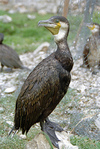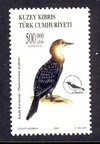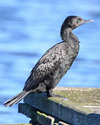Genus Phalacrocorax
Reed Cormorant - The Reed Cormorant , also known as the Long-tailed Cormorant, is a bird in the cormorant family Phalacrocoracidae. It breeds in much of Africa south of the Sahara, and Madagascar. It is resident but undertakes some seasonal movements.
Shag - This is a medium-large black bird, 68–78 cm long and with a 95–110 cm wingspan. It has a longish tail and yellow throat-patch. Adults have a small crest in the breeding season. It is distinguished from the Great Cormorant by its smaller size, lighter build, thinner bill, and, in breeding adults, by the crest and metallic green-tinged sheen on the feathers. Among those differences are that a shag has a lighter, narrower beak; and the juvenile shag has darker underparts. The European Shag's tail has 12 feathers; the Great Cormorant, 14 feathers. The green sheen on the feathers results in the alternative name "Green Cormorant" sometimes being given to the European Shag.
Imperial Shag - The taxonomy is very complex and species-limits within this group remain unresolved. The following are usually considered part of this group:
Double-crested Cormorant - The Double-crested Cormorant is a member of the cormorant family of seabirds. It occurs along inland waterways as well as in coastal areas, and is widely distributed across North America, from the Aleutian Islands in Alaska down to Florida and Mexico. Measuring 70–90 cm in length, it is an all-black bird which gains a small double crest of black and white feathers in breeding season. It has a bare patch of orange-yellow facial skin. Five subspecies are recognized.
Guanay Cormorant - The Guanay Cormorant is similar in coloration to the Rock Cormorant, Phalacrocorax magellanicus, but larger, measuring 78 cm from the tip of the bill to the end of the tail. Its bill is greyish with some red at the base. The face is red with a green eye-ring. It has roseate feet. The head, neck and back are black as are the outer parts of the thighs. The throat patch, breast and belly are white. In breeding plumage it has a few white feathers on the sides of the head and neck.
Neotropic Cormorant - The Neotropic Cormorant or Olivaceous Cormorant is a medium-sized cormorant found throughout the American tropics and subtropics, from the middle Rio Grande and the Gulf and Californian coasts of the USA south through Mexico and Central America to southern South America. It also breeds on the Bahamas, Cuba and Trinidad. It can be found both at coasts and on inland waters. There are at least two subspecies: P. b. mexicanus from Nicaragua northwards and P. b. brasilianus further south.
Cape Cormorant - It breeds from Namibia south to southern Cape Province. In the nonbreeding season, it may be found as far north as the mouth of the Congo, and also extends up the east coast of South Africa as far as Mozambique. In the 1970s, the breeding population was estimated as over 1 million in Namibia alone. However, the IUCN now classifies it as "Near Threatened" on the grounds of: ongoing pollution from oil slicks, disturbance to stocks of its prey, and pathogen or parasite increases.
Japanese Cormorant - The Japanese Cormorant has a black body with a white throat and cheeks and a partially yellow bill.
Common cormorant - The Great Cormorant is a large black bird, but there is a wide variation in size in the species wide range. Weight is reported from 1.5 kg . Length can vary from 70 to 102 cm and wingspan from 121 to 160 cm . It has a longish tail and yellow throat-patch. Adults have white thigh patches in the breeding season. In European waters it can be distinguished from the Common Shag by its larger size, heavier build, thicker bill, lack of a crest and plumage without any green tinge.
Rough-faced Cormorant - It is a large black and white cormorant with pink feet. White patches on the wings appear as bars when the wings are folded. Yellow-orange swellings are found above the base of the bill. The grey gular pouch is reddish in the breeding season. A blue eye-ring indicates its kinship with the other blue-eyed shags.
Bronzed Shag - The species is dimorphic in appearance. Roughly half the individuals are mostly dark bronze, but with white patches, similar to the King Shag; the remainder are bronze all over. The two morphs breed together indifferently. These chunky birds are 65–75 cm and weigh 1.8-3.9 kg .
Auckland Islands Shag - The Auckland Shag is considered vulnerable by the IUCN due to its small population size and restricted global range. Only around 2000 Auckland Shags exist in their remote habitat.
Crowned Cormorant - The Crowned Cormorant, Microcarbo coronatus, is a small cormorant that is endemic to the waters of the cold Benguela Current of southern Africa. It is an exclusively coastal species and is always found at least 10 km away from land. This species is related to the Reed Cormorant, and was formerly considered to the same species.
Black-faced Cormorant - The Black-faced-Cormorant feeds largely on small coastal fish, diving in depths up to 12 m. Fish of lengths up to 50 cm have been observed to be taken. The birds sometimes forage in flocks, apparently in an organised way.
Indian Cormorant - This is a common and widespread bird species, which breeds in freshwater wetlands. 3–6 eggs are laid in a nest in a tree.
Flightless Cormorant - With only 1500 estimated individuals, it is one of the world's rarest birds and is the subject of an active conservation program.
Rock Shag - At a distance, the Rock Shag is a black and white bird, with head, neck and upperparts black and chest and underparts white. Closer up, the black areas vary from metallic blue to oily green, and are flecked with white in places. The legs and feet are a pink, fleshy colour, and the bare flesh around the beak and eyes is brick red. In breeding condition, there is a blackish though not very prominent crest on the forehead, and a distinctive white ear patch. There is even less sexual dimorphism than in most cormorant species, but males are 5%-10% larger on most size measurements.
Little Pied Cormorant - The Little Pied Cormorant, Little Shag or Kawaupaka is a common Australasian waterbird, found around the coasts, islands, estuaries, and inland waters of Australia, New Guinea, New Zealand, Malaysia, and Indonesia, and around the islands of the south-western Pacific and the sub-Antarctic. It is a small short-billed cormorant usually black above and white below with a yellow bill and small crest, although a mostly black white-throated form predominates in New Zealand. Three subspecies are recognised. Until recently most authorities referred to this species as Phalacrocorax melanoleucus.
Bank Cormorant - The Bank Cormorant is a heavy-bodied bird, roughly 75 cm in length. It is generally black in appearance with a bronze sheen, though the wings are a dark brown rather than a true black. Adults have a small crest on their heads, and normally have a white rump.
Javanese Cormorant - Originally described by French ornithologist Louis Jean Pierre Vieillot in 1817, this is a common and widespread bird species. It breeds in freshwater wetlands and on coasts. 3–5 eggs are laid in a nest in a tree or long grass.
Socotra Cormorant - The Socotra Cormorant is an almost entirely black bird. In breeding condition, its forecrown has a purplish gloss and its upperparts have a slaty-green tinge, there are a few white plumes around the eye and neck and a few white streaks at the rump. Its legs and feet are black and its gular skin blackish. All these deviations from pure black are less marked outside the breeding season. Wing breadths of 275–310 cm have been recorded.
Chatham Islands Shag - Its natural habitats are open seas and rocky shores. It is threatened by habitat loss, and considered critically endangered by the IUCN.
Baird's cormorant - The Pelagic Cormorant , also known as Baird's Cormorant, is a small member of the cormorant family Phalacrocoracidae. Analogous to other smallish cormorants, it is also called Pelagic Shag occasionally. This seabird lives along the coasts of the northern Pacific; during winter it can also be found in the open ocean.
Brandt's cormorant - Brandt's Cormorants feed either singly or in flocks, and are adaptable in prey choice and undersea habitat. It feeds on small fish from the surface to sea floor, obtaining them, like all cormorants, by pursuit diving using its feet for propulsion. Prey is often what is most common: in central California, rockfish from the genus Sebastes is the most commonly taken, but off British Columbia, it is Pacific Herring. Brandt's Cormorant have been observed foraging at depths of over 40 feet.
Pallas's Cormorant - The species was first identified by Georg Steller in 1741 on Vitus Bering's disastrous second Kamchatka expedition. He described the bird as large, clumsy and almost flightless — though it was probably reluctant to fly rather than physically unable — and wrote "they weighed 12 – 14 pounds, so that one single bird was sufficient for three starving men." Though cormorants are normally notoriously bad-tasting, Steller says that this bird tasted delicious, particularly when it was cooked in the way of the native Kamtchadals, who encased the whole bird in clay and buried it and baked it in a heated pit.
Spotted Shag - Compared with typical cormorants, the Spotted Shag is a light-coloured bird. Its back is brown. Its belly is pale blue-grey , and the white continues up the sides of the neck and face, but the throat and the top of the head are dark blue-green. In the mating season, it has an obvious double crest. There is little sexual dimorphism.
Pygmy Cormorant - The Pygmy Cormorant breeds colonially in wetlands with still or slowly flowing fresh water in coastal deltas and well-vegetated freshwater lakes. It builds a nest of grass and twigs in a low tree or reedbed, into which it lays its 3-6 eggs. Both parents incubate for 27–30 days, and nestlings become independent after 70 days.
Little Black Cormorant - Adult in East Perth
Red-faced cormorant - The adult bird has glossy plumage that is a deep greenish blue in colour, becoming purplish or bronze on the back and sides. In breeding condition it has a double crest, and white plumes on the flanks, neck and rump, and the bare facial skin of the lores and around the eyes is a bright orange or red, giving the bird its name; although the coloration is less vivid outside the breeding season, the red facial skin is enough to distinguish it from the otherwise rather similar Pelagic Cormorant. Its legs and feet are brownish black. Its wings ranges from 25 to 29 cm in extent, with females having on average about 5 cm shorter wings. Adults weigh between 1.5 and 2.3 kg, with females averaging 350g less than males.
Pied Cormorant - In New Zealand its range on the east coast extends as far south as Christchurch, though this is a recent extension—older books report it no further south than Kaikoura.



















